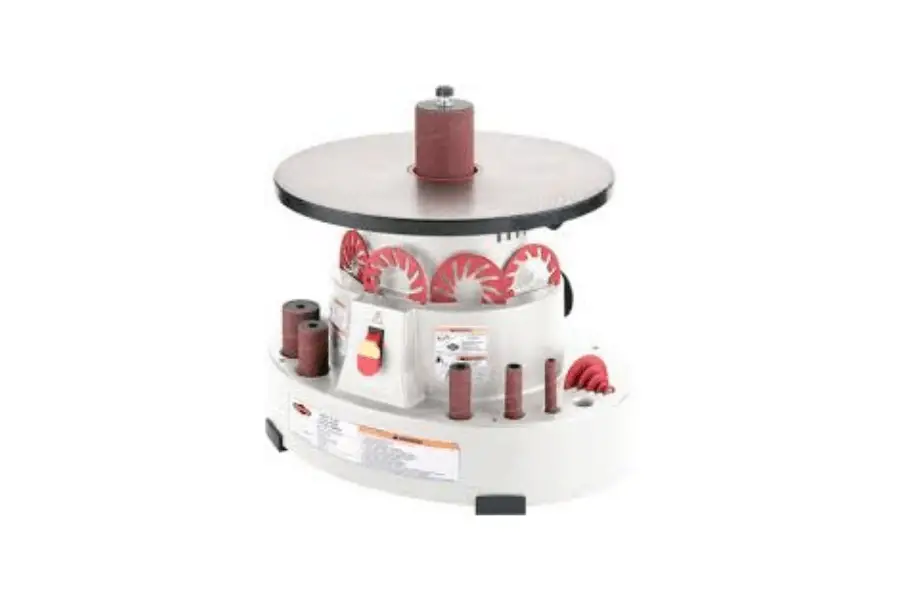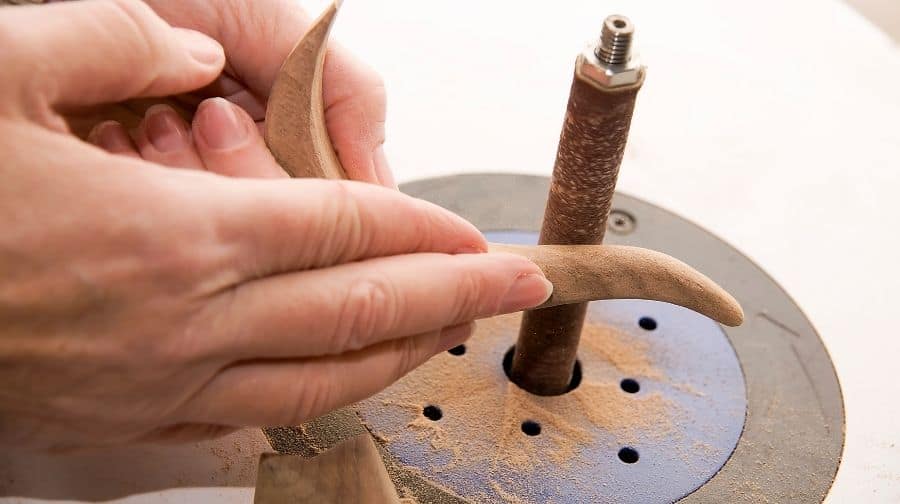
A spindle sander is a motorized, power-sander that was created and designed to help you achieve a smooth finish on exterior curves and other detail-work on wood. There are so many helpful options when it comes to sanding down your project. Each tool has a specific purpose and function that separates it from the others. I’ve researched through the internet and put together a quick summary on the Spindle Sander.
What is a spindle sander used for? The Spindle sander has an oscillating sanding drum that moves up and down used for sanding curves of various sizes on the interior and exterior of your work piece as well as sanding detailed pieces and creating a smooth flat finish. It typically uses an 80 or 150 grit sandpaper.
Keep reading below to learn more about the Spindle Sander and what it can be used for.
What Is A Spindle Sander?
Before we get lost in the quagmire of technical instruction, let’s first establish what a spindle sander is and what types of spindle sanders exist.
First, a spindle sander is a motorized, power-sander that was created and designed to help you achieve a smooth finish on exterior curves and other detail-work on wood. All spindle sanders have a work surface or platform with a hole in the middle.
Inside that hole, there is a threaded port where various sizes of cylindrical spindle drums screw into the machine. These drums are typically metal and are covered in a gritted, sandpaper sleeve and powered by an electric engine.
What Is An Oscillating Spindle Sander
Some spindle sanders may oscillate, moving up and down on the vertical axis. This vertical oscillation often helps to prolong the life of the sanding surface and helps prevent static friction that causes burns and other band marks on the wood.
What Are The Interchangeable Parts Of A Spindle Sander
- Spindle- a cylindrical drum, typically made of steel, however, some smaller models may use rubber. The spindle is the aspect of the machine that rotates and does the work of sanding. In all cases, the spindle is covered in a tube of sandpaper.
- Throat Plate– a circular piece of metal that is fitted to the hole of the motor to cover any gaps near the spindle. Throat plates come with different-sized holes in them to fit appropriately to the size of spindle required.
Spindle sanders come in a variety of sizes. Some spindle sanders are small and portable enough to be placed on a benchtop or tabletop already in your workshop, while others are much larger and are part of an entire worktable.
The size of your spindle sander reflects the size and power of its engine and determines the size of the job. As any seasoned woodworking veteran will tell you, choosing the correct tool for the job is the first step. Shop around and do your research before purchasing.

What Is A Spindle Sander Used For?
A spindle sander is a tool used for smoothing curved edges on wood. We often make curved cuts on wood with a band saw and then spend hours meticulously sanding those curved edges or circular cutouts by hand.
Sanding by hand, is tedious and is not always accurate. It is easy to sand off more on one side than the other, and then you’re spending more time than necessary trying to even things back out. With a spindle sander, you can easily change out your spindle for one with a larger or smaller diameter, depending on the job.
The machine does the work for you, and using the same spindle for symmetrical curves helps maintain consistency. Not only will the spindle sander help you keep things uniform it also helps reduce the amount of time required to finish the piece.
Pro Tip
- For an exterior curve– Choose a spindle that is large enough to fit the curve that you have cut. Do NOT select a spindle that is too small and attempt to “eyeball it,” this will end poorly. Using the correct size spindle drum will help to keep things smooth and give you a more accurate line. Again, too small, and you may find yourself making unnecessary errors and lengthening your project time.
- For an interior curve or circular cut– It’s recommended that you use a spindle drum that is smaller in diameter than the hole you are sanding. The reason for this is that if the spindle does not have enough room to move, the piece that you are working on could choke down on the spindle and begin rotating freely. In other words, your piece could become a spinning helicopter blade of sorts and cause significant injury. If this occurs, do NOT attempt to power down the machine with the switch, simply unplug it from the power source.
How To Sand A Straight Edge With A Spindle Sander.
Spindle sanders are not only good for smoothing out exterior curving lines or interior circular cuts but also straight edges. To sand a straight edge with a spindle sander, you must first make a fence jig. There are many articles out there that may offer an overly complicated way of building a jig by drilling a hole in a 2×4 and all this extra, but it does not have to be so complicated.
The easiest way to do this would be to simply find a flat board, possibly a 2×4, and clamp it to the edge of your workstation at the appropriate distance from your sanding spindle. You will then simply feed your piece through the gap between the fence jig and the rotating spindle.
Should I Use A Dust Collector On A Spindle Sander?
As any woodworker knows, sawdust tends to accumulate quickly, especially where power tools are involved. Spindle sanders, oscillating or otherwise, are no exception. Clearing away saw dust from the work surface is very important when making clean cuts or when sanding a smooth edge.
Potential Hazards of Saw Dust
- Fire
- Burns on the wood
- Clogging up tools
In order to circumvent these issues, many spindle sanders will have a dust port built into the backside of the machine. If your machine does not have a built-in dust collector, it’s recommended that you use a shop vacuum. Make certain to turn on, whichever device you have before sanding to avoid any of the hazards listed above. Also, make certain to use the appropriate throat plate to maintain high airflow pressure, allowing for better dust collection.
What Sandpaper Grit Do I Use On A Spindle Sander?
For any sanding operation, using progressively finer abrasive grit as you progress will provide the best results. Begin sanding with a coarse grit (60 to 100), then repeat the process with a medium grit (120 to 180), and finish with a fine grit (220 and higher). With each progressive sanding, you will reduce any marks or abrasions created by the coarser grit of the previous sanding. Progressive sanding will give you the smoothest and best results.
How to use Oscillating Spindle Sander safety
Subscribe to Nicholas Kosloski on Youtube
